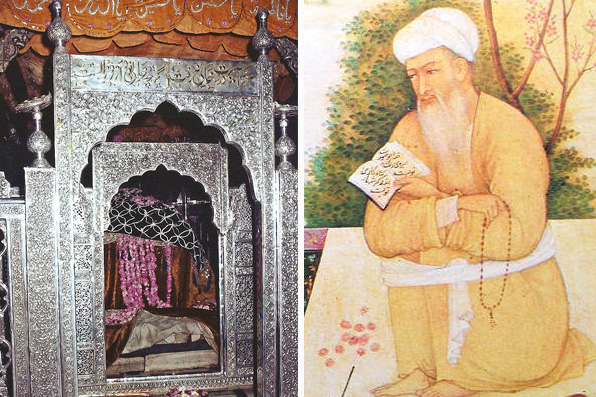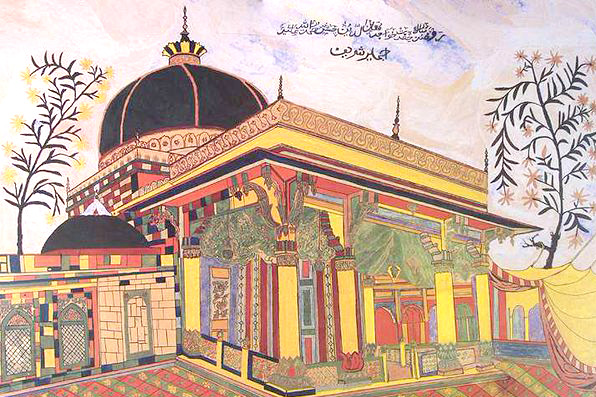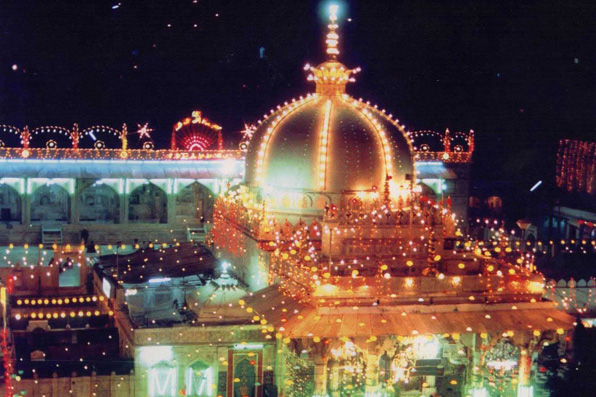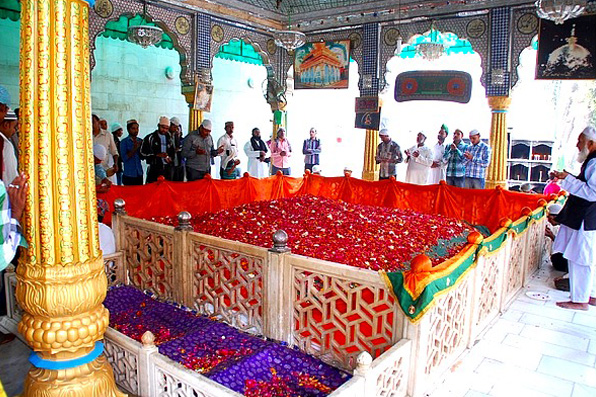Sheikh Khwaja Sayyidd Moinuddin Hasan Chisti RA – URS 6th Rajab
Sheikh Khwaja Sayyid Moinuddin Hasan Chisti RA – URS 6th Rajab
Sheikh Khwaja Sayyid Moinuddin Hasan Chisti RA – URS 6th Rajab.
Sheikh Khwaja Sayyid Moinuddin Hasan Chisti (RA) (also spelt Moinudeen, Moin-ud-din, Muinuddin) also known as Gharib Nawaz (Benefactor of the poor) was one of the most outstanding saints of the Indian subcontinent, and indeed an international spiritual inspiration who lived during the 6th Century AH (12th Century AD). He introduced and established the Chisti order in South Asia and significantly contributed to the spreading of Islam there.
Birth
Khwaja Moinuddin Chisti (ra) was born in Sanjar within the region of Sistan in modern-day Iran. Another source says he was born in Isfahan. He was born in 530 AH (1136 AD).
At the time of his birth, Sistan and its surrounding lands were experiencing unprecedented bloodshed and plunder at the hands of Tatars, and other rebels. These intruders had taken advantage of the weak government of Sultan Ahmed Sanjar.
Due to these disturbances in Sistan, Khwaja Ghiyasuddin Hasan (RA), father of Khwaja Moinuddin Chisti (RA), decided to leave Sistan for a safer place. He migrated with his family to Khorasan. It was a great hub of intellectual and economic activity and was home to learned Ulama and reputed Sufis. There were rich gardens and canals along with flourishing agricultural fields. Khwaja Ghiyasuddin Hasan (RA) settled down in the vicinity where he bought an orchard along with a windmill.
Early Life
During his childhood he showed early promise of a marvellous personality, displaying rare piety and sacrifice for others.
On the occasion of a certain Eid, when he was still a child, Khwaja Moinuddin Chisti (RA), richly attired, was going to Idgah to offer his prayers. On the way, he saw a blind child dressed in torn clothing. Deeply moved, he gave the child his own clothes and accompanied him to the Idgah. When only three or four years old, rather than playing with children of his age, he would invite these children to eat with him.
Khwaja Moinuddin Chisti (RA) was brought up in Khorasan and received his early education at home. When he was nine years old, he committed the Holy Quran to memory. Subsequently, he was admitted to a Maktab, where he concentrated primarily on the hadis and fiqh (jurisprudence), and completed his education very early.
Khwaja Moinuddin Chisti (RA) was about fifteen years old when his father died in 544 AH. He was extremely heart-broken. Prior to his father’s death, the Tatar invaders had entered Khorasan and ransacked the province. Hardly a year had passed since the death of Khwaja Moinuddin Chisti’s (RA) father, when the Tartars once more ransacked Khorasan and repeated the same drama. He was overwhelmingly dismayed to see these scenes of terrible devastation.
Turning Point
One day, when he was watering his garden, between the months of Shaban and Zul-Hijjah in the year 544 AH/1150 AD, a mystic named Ibrahim Qandoozi (RA) unexpectedly entered. Khwaja Moinuddin Chisti (RA) extended to him the utmost courtesy and a hearty welcome, and offered him a bunch of grapes. The mystic was greatly pleased by the hospitality and the respect shown to him and wanted to repay Khwaja Moinuddin Chisti (RA). He took out a piece of oil cake and upon chewing a portion of it, gave the rest to Khwaja Moinuddin Chisti (RA) to eat. As soon as he had eaten it, he underwent a strange transformation. He felt repugnance for mundane matters and sought to pursue the higher virtues and seek out the truth.
After the death of his father, he had inherited a grindstone and the orchard, which constituted his source of income. He sold his grindstone and the orchard and distributed the proceeds of these amongst the needy, the indigent, and the poor.
Spiritual Journey
In those days, Baghdad, Samarkand, and Bukhara were celebrated centres of Islamic learning. From Khorasan he proceeded to Samarkand and then to Bukhara, where he pursued higher studies. He stayed there for about five years, from 544 AH/1150AD up to 550 AH/1155AH continuing his education up to the age of twenty. He counted among his teachers the two outstanding scholars of his time, namely, Maulana Husamuddin of Bukhara (RA) and Maulana Sharfuddin (RA).
When Khwaja Moinuddin Chisti (ra) had acquired the best knowledge and wisdom of the time, he travelled widely in search of a spiritual guide who could provide him with the best spiritual guidance.
He reached Iraq in 551 AH/1156 AD where he met the renowned saint Hazrat Sheikh Abdul Qadir Jilani (RA), better known as al-Ghawth al-A’zam, in Baghdad for the first time. On meeting Khwaja Moinuddin Chisti (RA), Hazrat Sheikh Abdul Qadir Jilani’s (RA) forecast for him was:
This young man will be a great figure of his time. He will be a source of inspiration and a centre of devotion and the focus of affection to myriads of people.
The prophecy proved correct.
Subsequently, Khwaja Moinuddin Chisti (RA) left Iraq for Arabia, and from there he proceeded to Haroon in Iran. In Haroon, he had the unique privilege of meeting the famous saint Hazrat Khwaja Usman Harooni (RA), who accepted him as his spiritual disciple.
He spent two and a half years in the company and service of Hazrat Khwaja Usman Harooni (RA), acquiring spiritual attainments and undertaking ascetic practices, and eventually won the approval of his spiritual guide and teacher. He was given the permission to enlist and accept disciples himself and was appointed a spiritual caliph.
He left Haroon for Baghdad, where he met Sheikh Abu Najeeb Suhrawardi (RA). In 555 AH/1160 AD, he travelled to Syria where he met a saint called Ohad Mahmud Al-Wahidi Ghaznavi. He then proceeded to Kerman and from there he returned to Baghdad, and then proceeded to Hamedan.
On his way to India, he visited Tabriz, Astarabad, Bukhara, Kharqan, Samarkand, Memna, and Herat. He finally reached Multan on the tenth of Muharram of 561 AH/1165 AD. He then left Multan for Lahore where he spent time at the tomb of Hazrat Sheikh Ali Hujwiri (RA) better known as Data Ganj Bakhsh.
On his return journey, he visited Ghazni, Balkh, Astarabad, and Rey. On reaching Baghdad, he offered his respect to his spiritual guide and teacher Hazrat Khwaja Usman Harooni (ra), who was then in Baghdad.
Initiation as a Disciple a Second Time
Khwaja Moinuddin Chisti (RA) himself describes the details of his being initiated as a spiritual disciple a second time in the following words:
I, Moin-ud-din Hasan of Sanjar, well-wisher of all the faithful, had the honour of meeting His Holiness Hazrat Khwaja Usman of Haroon in the mosque of Khwaja Junaid in Baghdad. His Holiness was surrounded by inspired dervishes.
When this humble being bowed low in due deference, my spiritual guide and teacher Hazrat Khwaja Usman of Haroon asked me to offer two genuflections. I did.
Then His Holiness asked me to sit with my face towards the Ka’ba. He asked me, next, to recite Sura Baqara. I did as I was asked to do.
Further, His Holiness commanded me to recite benedictions to the Holy Prophet Mohammad twenty-one times. I obeyed.
Then His Holiness stood up and, holding my hand in his, lifted his face towards the sky and said to me: ‘Come, let me cause thee to reach God.’
Subsequently, taking out a miqraz, turned it around on the head of this humble being and placed on my head the four-edged cap and bestowed on me the robe. Then he asked me to sit. I sat. He addressed me thus: ‘It is the custom with us that a new entrant has to go through asceticism for one day and one night. Thou shouldst complete it in this one day and night.’ I obeyed. Next day, when I attended upon him, His Holiness asked me to sit down and recite Sura Ikhlas (Purity of Faith) four thousand times. I did that.
He asked me, next, to look towards the sky. I did. His Holiness asked me: ‘How far dost thou see?’ I replied: ‘Up to the Great Throne.’
Next, he asked me to look towards the ground. I did, He asked me ‘How far dost thou see?’ I replied: ‘Up to the Antipodes.’
Next, he asked me to recite Sura Ikhlas (Purity of Faith), again, a thousand times. I did. He asked me to look towards the sky again. I did. He asked me: ‘How far dost thou see now?’ I replied: ‘Up to the Great Hidden.’
He asked me next to close my eyes. I did. He asked me to open my eyes. I did.
Then, showing his two fingers, he asked me:’ What dost thou see therein?’
I replied: ‘Eighteen thousand worlds.’
Later, pointing towards a brick ahead, he asked me to pick it up. When I did, I found a handful of dinars therein. He said to me: ‘Go and distribute them amongst the needy and the poor.’ I complied. When I went to him subsequently, he said to me: ‘Live in our company for some time.’ I replied: ‘I am at your service, Sir.’
Hajj
Khwaja Moinuddin Chisti (RA) accompanied his spiritual guide and teacher wherever he went. They left Baghdad for Makkah, and on their way, they stayed for sometime in Fallujah. About the visit to Mecca, Khwaja Moinuddin Chisti (RA) himself says:
Having reached Mecca, we were honoured by the glorious vision of the Ka’ba and by going around it. My spiritual guide and teacher here, too, took my hand in his and entrusted it to God Almighty. He prayed for my humble self in Ka’ba. A voice was heard to the effect that: ‘We have accepted Moin-uddin.’
Then we reached Medina. We offered our respects at the Court of the Holy Prophet Mohammad ﷺ. My spiritual guide and teacher said to me: ‘Make thy respectful salaams.’ I offered my reverential salaams.
A voice came out saying: ‘Peace be on you also, O Head of the Pious of the Earth and the Sea.’ On hearing this, my spiritual guide said to me: ‘Now indeed thou hast reached perfection.’
Leaving Medina, they stopped in Osh, Badakhshan, and Bukhara on their way to Baghdad. After staying in Baghdad for some time, Hazrat Khwaja Moinuddin Chisti (RA) once again accompanied his spiritual guide and teacher on his tours and travels, visiting Osh, Siwistan, and Damascus.
Khwaja Moinuddin Chisti (RA) met Hazrat Sheikh Abdul Qadir Jilani (RA) in Gail a second time in 581 AH/1185 AD and stayed with him for fifty-seven days.
Initiation into the Spiritual Order
After having served his spiritual guide teacher on tours and travels for twenty years, Khwaja Moinuddin Chisti (ra) was separated from him in Baghdad, when he was fifty-two years of age.
On this occasion, Hazrat Khwaja Usman Harooni (RA) appointed him as his Sajjada nashin, his spiritual successor, and conveyed to him the holy relics of the Holy Prophet Mohammad ﷺ. Of this Khwaja Moinuddin Chisti (RA) himself says:
My spiritual guide and teacher gave me the stick that was placed before him and then honoured me by confiding to me the robe, sandals, stick and the prayer carpet. Then addressing me said thus:
‘These holy relics are the sacred possessions of our spiritual ancestors, which we have received from the Holy Prophet Mohammad ﷺ and I have given them to thee. Thou should’st keep them with thee, as we have done. Whomsoever thou may’st find a real seeker, entrust them to him. Do not hold any hope from the people. Live far from the people and aloof from the public and do not demand or ask anything from anybody.’
Having said these words, my spiritual guide and teacher embraced me and kissed my head and eyes and said: ‘I have entrusted thee to God.’ Then he went into trance and I departed.
Hajj and the Prophet’s ﷺ Command
Khwaja Moinuddin Chisti (RA), after receiving the robe of caliphate from his spiritual guide and teacher, left on tours and travels again. He first reached Osh and then moved on to Isfahan where he met Sheikh Mahmud of Isfahan. He gave the clothes that he was wearing to Khwaja Qutbuddin Bakhtiar Kaki (RA), implying that he had accepted him as his spiritual disciple. Thereafter, Khwaja Qutbuddin Bakhtiar Kaki (ra) accompanied him on tours and travels in the year 583 AH/1187 AH. Khwaja Moinuddin Chisti (RA) left Isfahan for Makkah the same year. One day when he was absorbed in prayers in the Ka’ba, he heard a voice saying:
O, Moinuddin! We are greatly pleased with thee. Thou art given salvation. Ask for anything thou may’st like, so that we may grant that to thee.
He respectfully responded:
O, Great God! Grant salvation to the followers and disciples of Moinuddin.
He received the reply:
O, Moinuddin! Thou art our accepted one. I will give salvation to thy followers and disciples and also to those who may enter thy fold till the Day of Resurrection.
O, Moinuddin! Thou art a helper of my religion. I entrust to thee the country of Hindustan. There prevails darkness. Proceed to Ajmer and spread there the Gospel of Truth.
He was immensely pleased with this mandate but wondered where Ajmer was situated. In the meanwhile, he was consumed with drowsiness. He was blessed by seeing the Holy Prophet Mohammad ﷺ in a dream who showed him the city, the fort, and the situation of Ajmer. He was bid farewell and was given a pomegranate from heaven. After paying respects to the Ka’ba and performing the hajj he reached Medina and devoted himself to prayers in the Kaaba mosque. During his stay, he received a mandate from the Court of the Holy Prophet Mohammad ﷺ to the effect:
Khwaja Moinuddin Chisti (ra) reached Baghdad and moved on to Chisht on his way to Herat. From Herat, he proceeded to Sabzevar, which was ruled by Yadgar Mohammed, who also became his spiritual disciple.
He left Sabzevar and reached Shadman Fort, and then left for Lahore via Multan. He then proceeded to Delhi and stopped on the way at Samana (in the Patiala district), and from there, reached Ajmer for the first time in 587AH/1191 AD. He had forty followers with him.
Spiritual Chain
His spiritual chain is traced back to the Beloved Prophet ﷺ as follows:
- Hazrat Khwaja Moinuddin Hassan Chisti (ra), disciple of
- Hazrat Khwaja Usman–e-Harooni (ra), disciple of
- Hazrat Haji Sharif Zindani (ra), disciple of
- Hazrat Khwaja Qutubudin Modood Chisti (ra), disciple of
- Hazrat Khwaja Nasir Uddin Abu Yousuf Chisti (ra), disciple of
- Hazrat Khwaja Abu Mohammed Chisti (ra), disciple of
- Hazrat Khwaja Abu Ahmed Abdal Chisti (ra), disciple of
- Hazrat Khwaja Abu Ishaque Shami Chisti (ra), disciple of
- Hazrat Mumshad Uluvi Deenwari (ra), disciple of
- Hazrat Khwaja Aminuddin Habeera (ra), disciple of
- Hazrat Khwaja Huzaefa Marashi (ra), dsciple of
- Hazrat Khwaja Ibrahim Adham Balkhi (ra), disciple of
- Hazrat Khwaja Fuzail Ibne Ayaz (ra), disciple of
- Hazrat Khwaja Abdul Wahid Bin Zaid (ra), disciple of
- Hazrat Khwaja Imam Hassan Basri (ra), disciple of
- Hazrat Imamul Auliya Sayedna Hazrat Ali
 , son-in law of
, son-in law of - The Holy Prophet Hazret Mohammad Mustafa ﷺ
Khwaja Moinuddin Chisti (RA) in Ajmer
At that time, Ajmer was ruled by Prithvi Raj Chauhan, the famous Rajput king. In Ajmer, he wanted to stay at the site where the Auliya mosque is now situated but the servants of Prithvi Raj Chauhan did not allow him to do so on the pretext that the camels of Prithvi Raj Chauhan usually sat there. Khwaja Moinuddin Chisti (ra) thereupon countered: “If the camels sit there, let them sit.” He then stayed on a Hill close to Ana Sagar lake and occupied the site now known as Chillah Khwaja Sahib. The camels returned to their usual place and sat there as usual, but once they sat, they were unable to stand up again. The Raja was informed. All the camel-drivers tendered an unconditional apology. Khwaja Moinuddin Chisti (RA), accepting the apology said: “Well, go. The camels now stand.” When they returned, they saw the camels were standing.
When the news spread that a very pious dervish had come to Ajmer, people began to flock to him in increasing numbers. Whoever came to him, received the kindest treatment and blessings. People were so much inspired by his divine teachings and simplicity that they began to embrace Islam. Many became his disciples.
Meanwhile, Shahabuddin Muhammad Ghori again attacked India, in 1192 AD, and in the famous Battle of Tarain, defeated Prithvi Raj Chauhan. When Shahabuddin Muhammad Ghori came to know of the presence of Khwaja Moinuddin Chisti (RA) at Ajmer, he personally came to see him and enjoyed the grace of his meeting.
Khwaja Moinuddin Chisti (RA) left Ajmer for some time and returned again to Ajmer in 588AH/1191 AD. He left for Baghdad in 598 AH/1200 AD and on reaching Balkh, he accepted Maulana Ziauddin (RA) as his spiritual disciple. He visited Ajmer a third time in 602 AH/1206 AD and once again in 610 AH/1213 AD.
He visited Delhi twice during the reign of Sultan Shamsuddin Iltutmish. He reached Delhi in 611AH/1214 AD and stayed in the Khanqah of Khwaja Qutbuddin Bakhtiar Kaki (ra), and during his stay, he conferred a robe on to Hazrat Baba Fariduddin Ganjshakar (RA).
When his spiritual guide and teacher, Hazrat Khwaja Usman Harooni (RA), paid a visit to Delhi, Khwaja Moinuddin Chisti (RA) requested that “some calm, quiet and secluded place may be chosen for his permanent abode and stay,” to which His Holiness responded: “O, Moinuddin! Live in my company for sometime once again so that thou may’st acquire spiritual powers through the constancy of my training and preaching and after that permanently settle in Ajmer.” The renowned poet of Shiraz, Sheikh Sa’di (RA) came to Delhi at that time and had the privilege of meeting both the saints.
Khwaja Moinuddin Chisti (RA) once again visited Delhi in 621AH/1224 AD at the request of a certain farmer, who implored him to ask the king to set aside the order of confiscation of the produce of his land passed by a certain officer.
He wanted to take Khwaja Qutbuddin Bakhtiar Kaki (RA) with him to Ajmer as Sheikh Najmuddin Sughra (RA) had complained to him that the presence of Qutb Sahab in Delhi eclipsed his importance and prestige, but when implored by the high and the low of Delhi not to do so, permitted him to remain in Delhi and entrusted the city to his care. He himself returned to Ajmer. Khwaja Moinuddin Chisti (RA) continued his noble magnificent mission, showing the Path of Truth to the people. He also sent his disciples and successors to the different part of the country who also served the people and preached the tenets of Islam. A few of his prominent successors are:
- Hazrat Khwaja Qutbuddin Bakhtiar Kaki (RA) (Delhi)
- Hazrat Sheikh Baba Fariduddin Ganjshakar (RA) (Pakpattan)
- Hazrat Sheikh Nizamuddin Auliya (RA) (Delhi)
Character of Khwaja Moinuddin Chisti (RA)
Khwaja Moinuddin Chisti (RA) was very fond of music and fell unconscious in a state of rapture when listening to it. He always appeared to be solemn and sad, and had the utmost respect and regard for his spiritual guide and teacher. Very absorbed, he kept his eyes closed when lost in contemplation, but opened them at prayer time. He followed the precepts of the Holy Prophet ﷺ in everyday life. Fear of God would cause him to tremble and weep and the dread of the last resting place, the grave, also dominated his thoughts. Sometimes he felt in an elevated mood and was then so much absorbed and lost in meditation that he was quite unmindful of what was going on around him. At other times, he was consumed by a pensive mood, and then he would close the door of his tenement in order to devote himself to contemplation.
He had a forgiving nature and showed love, regard, and respect to all, irrespective of caste, creed, or religion. He was cosmopolitan in outlook, and a man of generous disposition, taking pleasure in helping the poor and the needy.
He was renowned for his hospitality and entertained the people. Myriads of people of the city, with no ostensible means of subsistence, depended upon his langar (free distribution of food). He himself ate very little, fasting throughout the year, and wore patched clothes. Very fond of prayers, he would read the Quran twice a day. He took no rest or respite for seventy long years and was very particular about his ablutions.
He showed utmost concern for the well-being of his spiritual disciples and was greatly loved by his spiritual guide and teacher Hazrat Khwaja Usman Harooni (ra) who said of him: “Our Moinuddin is a beloved of God and I feel proud of the fact that he is my disciple.”
He took to renunciation and self-abnegation.
Death of Khwaja Moinuddin Chisti (RA)
On Monday the sixth of Rajab in 627 AH (21 May 1230 AH) he closed the door of his tenement and instructed his attending devotees not to disturb him that night. Throughout the night the people outside heard a mystic sound emerge from it, a sound of ecstacy. At the approach of dawn, all was silent.
When the door remained closed at the time of morning prayers, his devotees and disciples thought this was strange. The door was opened, and there he lay. The following sentence in Arabic was radiantly glittering on his forehead: “He was a beloved of God and he died in the love of God.” Haaza Habib-Allah Mata Fee Hoob-Allah (He is God’s beloved and he died in God’s love)
Maqam
Sultan Ghiyasuddin constructed Hazrat Khwaja Moinuddin Chisti’s (RA) mausoleum in 1464 AD and constructed the dome over it on around 1464-1500 AD. After sometime, Emperor Akbar re-modelled the Shrine in 1564 AD. Subsequently, alterations and modifications were made by Emperor Shah Jahan.
The tomb is always covered with precious gilaphs (sheets of expensive cloth) with rich embroidery work all over, which are presented by the followers and devotees of the Holy Saint. The inside of the dome and the walls are artistically engraved and embellished in gold tracing. The top of the shrine is always covered full length with fresh fragrant flowers, mostly roses and jasmine. The shrine is surrounded by two silver screens.





